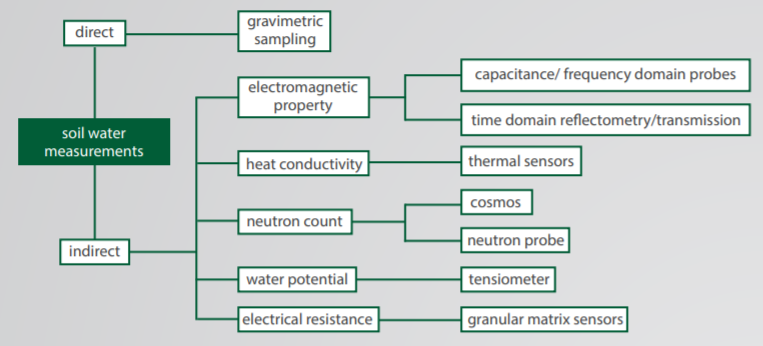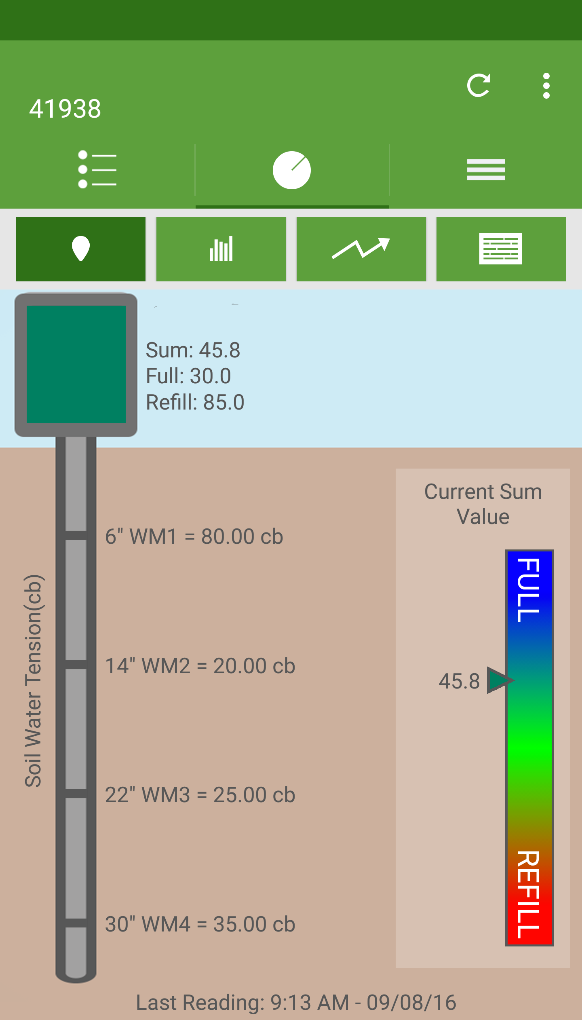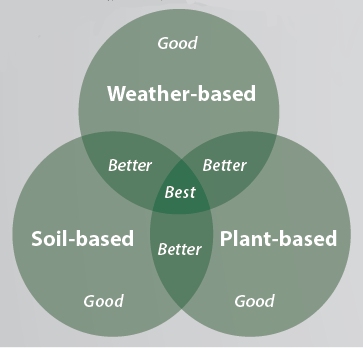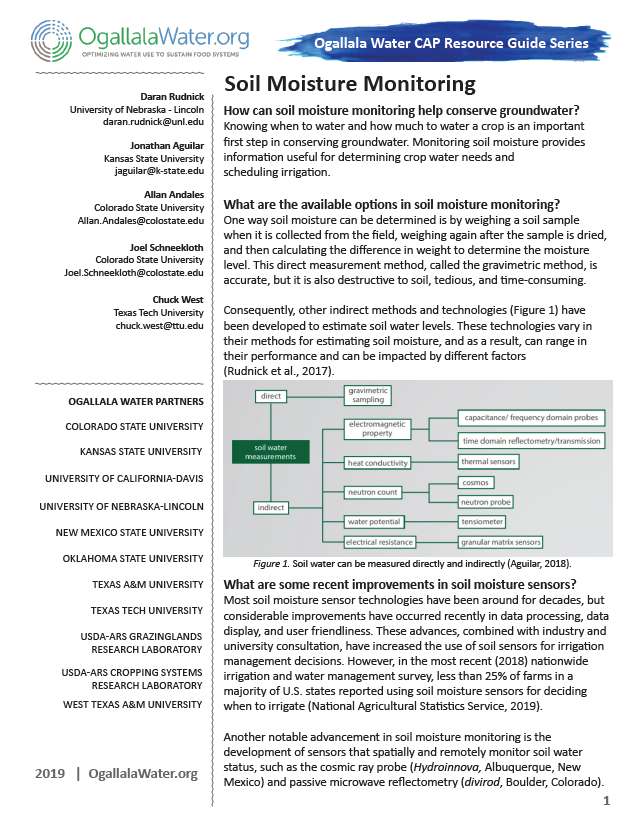Knowing when to water and how much to water a crop is an important first step in improving water use efficiency and conserving groundwater.
Effectively monitoring and making water-use decisions using soil moisture data, while having a good understanding of shifts in crop water demand throughout the growing season, can help farmers increase their water-use efficiency, on-farm profitability, and potentially how much groundwater they can conserve, particularly in normal-to-wet growing years.
Although soil moisture monitoring should not be expected and solely relied upon to provide a high degree of precision and accuracy in all scenarios, moisture sensors can still prove to be a useful tool when combined with feedback from other tools and methods used to assess soil moisture and crop water needs.
Several options exist for determining soil water levels. In addition to feeling soil moisture by hand, another way soil moisture is often determined is by weighing a soil sample when it is collected from the field, weighing again after the sample is dried, and then calculating the difference in weight to determine the moisture level. This direct measurement method, called the gravimetric method, is accurate, but it is also destructive to soil, tedious, and time-consuming.
Consequently, other indirect methods and technologies (Figure 1) have been developed to estimate soil water levels. These technologies vary in their methods for estimating soil moisture, and as a result, can range in their performance and can be impacted by different factors.

Figure 1. Soil water can be measured directly and indirectly.
Most soil moisture sensor technologies have been around for decades, but considerable improvements have occurred recently in data processing, data display, and user friendliness. These advances, combined with industry and university consultation, have increased the use of soil sensors for irrigation management decisions. However, in the most recent nationwide irrigation and water management survey, less than 25% of farms in a majority of U.S. states reported using soil moisture sensors for deciding when to irrigate (National Agricultural Statistics Service, 2019).
“Having a soil probe in each of our irrigated circles has definitely saved us money. How we manage water on our farm using the probes and residue helps keep nutrients in the root zone, preventing money we’ve spent on them from leaching or washing away.”
Another notable advancement in soil moisture monitoring is the development of sensors that spatially and remotely monitor soil water status, such as the cosmic ray probe (Hydroinnova, Albuquerque, New Mexico) and passive microwave reflectometry (divirod, Boulder, Colorado).
Advances in spatial water monitoring can help identify differences in crop water availability across the field, so that irrigation can be triggered based on field-level economic thresholds and/or the use of variable rate irrigation. Furthermore, spatial soil water status can help inform other agronomic practices, such as planting date and depth, hybrid/cultivar type, population density, and nutrient management.
General tips for choosing which soil moisture sensor(s) to use
When selecting a soil moisture sensor for an intended use, it is important to understand how each sensor works in order to compare advantages and disadvantages among sensor options. In addition to sensor accuracy, the following factors should also be considered:
- convenience - easy to install and maintain
- financial costs
- remote access capability
- product support
- susceptibility to influencing factors
- number of sensors required
- sensor spacing, volume, and response time
- integration with weather-based and plant-based moisture sensors and data
It may be advantageous to install sensors at multiple soil depths (Figure 2). Shallow soil depths may be dry, but water may be available at deeper depths where crop roots are actively growing. Tremendous insight can be provided by observing sensor responses over time at various depths, including: the extent and depth of root growth, infiltration depth of irrigation and precipitation, soil field capacity (water retained in a freely drained soil about two days after wetting), and possible evidence of over- or under-irrigation.
Another consideration is understanding how a sensor and any accompanying technologies express soil moisture levels (centibars, percent volumetric water content, index values) and how these values should relate to irrigation schedules. Figure 2 (below) demonstrates one app display example that expresses moisture levels as soil water tension, which is a measure of the force necessary for plant roots to extract water from the soil. Higher soil water tension means soils are drier.

Figure 2. Example of a mobile phone app display expressing soil moisture in two ways: (left) as soil water tension (centibars) at various soil depths and (right) with a color scale “Full-Refill” graphic.
Correctly selecting, installing, and maintaining sensors can be challenging but but necessary. For a producer to gauge if the data the moisture probes are providing are offering a representative picture of soil moisture status on their operation, he or she needs to factor in:
- having an adequate number of sensors (or measurements)
- sensor placement
- representative sensing volume
- adequate sensor response time
- reasonable soil moisture “full” and “refill” levels specific to soil type
Soil moisture sensor accuracy can be affected by several factors including temperature, salinity, and soil texture. In addition, although some sensors may report moisture levels to the nearest hundredth of an inch, producers should evaluate irrigation applications to the nearest tenth of an inch, reflective of the overall application accuracy irrigation systems can achieve due to variation across the entire system.
“There is no ideal soil water content sensor. They all have their advantages and disadvantages. The best sensor for your application is the one that gives you what you care about most. There are a lot of good sensors available, and if you understand what the sensor is really measuring, then is becomes easier to compare them and make the best choice for your application.”
Soil moisture monitoring is one of three available methods to estimate crop water needs (Figure 3):
- soil-based
- weather-based
- plant-based
Soil-based information work together with other crop water estimation methods. For example, irrigation scheduling tools that use water balance models based on weather information can work together with soil moisture sensors. While models can provide acceptable irrigation requirement estimates, their errors can accumulate through the growing season. Using occasional soil moisture measurements within the growing season to correct weather-based water balance models can be an effective approach to take advantage of both technologies.

Figure 3. Using more than one method of estimating crop water needs can provide greater confidence in estimating soil moisture
“Soil water sensing should be integrated with other water management technologies for the best results. We should always try to avoid using a single technology to manage irrigation…Nothing can substitute going out into the field and seeing what is going on.”
WATCH: videos from a Soil Moisture Sensor Field Day Demonstration featuring multiple soil moisture sensors, as well as information on sensor installation, operation, and data interpretation. This field day took place on March, 2017 near Holcomb, KS, at the Roth/Garden City Company Water Technology Farm.
Publications
-
Clay soils; Nebraska; soil moisture sensors; calibration; soil moisture; irrigation management
-
soil moisture sensors, Nebraska, loam soil, calibration, irrigated production systems, irrigation management, soil water content, soil moisture monitoring
-
Interreplicate variability helps explain some sensors’ data output errors for soil volumetric water content
More Information
- University of Nebraska-Lincoln: How to Schedule Irrigation with Soil Water Data Video Series: 1) Irrigation Scheduling Basics; 2) Equipment Installation; 3) Irrigation Scheduling; 4) Advanced Irrigation Scheduling; 5) End of Season Irrigation Scheduling
- University of Nebraska-Lincoln: Value of Using Sensors to Manage Irrigation and Tips for Proper Installation
- Texas A&M Agrilife Extension: Irrigation Monitoring with Soil Water Sensors


